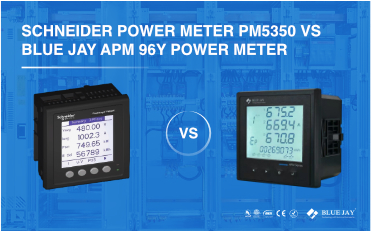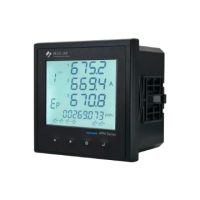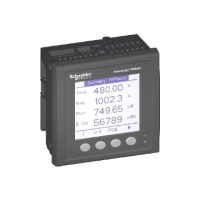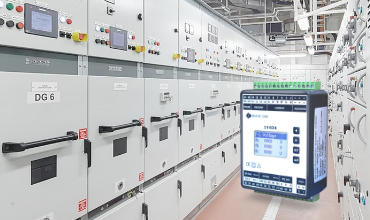
Power Quality Metering and Monitoring Solutions
Table of Contents Want to know Power Quality Metering

The Schneider Power Meter PM5350 belongs to one type of basic multi-function power meter, which includes the METSEPM5350 and METSEPM5350P (PM5350p). The primary difference between them lies in the harmonic measurement and the multi-tariff function. The PM5350p MFM meter Schneider can measure up to the 31st harmonic with a multi-tariff function, while the METSEPM5350 Schneider MFM meter can measure up to the 15th harmonic without a multi-tariff function. While the Schneider PM5350 is a common choice for a multi-function power meter, our Blue Jay APM96Y provides a compelling alternative. In this article, we’ll directly compare the two devices to help you understand their respective capabilities.
Both Schneider PowerLogic PM5350 and Blue APM96Y can measure Energy, Active and Reactive Power, Voltage, Current, Frequency, Power Factor, Apparent power, and total harmonic distortion. Equipped with a data recording and an alarm function, they are similar in installation(panel mounted), size(96*96mm), backlit LCD display, and compatibility with 1P+N, 3P, and 3P+N networks.


Schneider PM5350 power meter and Blue APM96Y are some differences in power quality analysis, accuracy class, DI& DO, Communication, etc.
Power quality analysis
While the Power meter 5350 Schneider can typically measure Total Demand Distortion (TDD), the standard Blue Jay APM96Y does not. However, Blue Jay can measure max demand and customize the meter to include this feature upon request. Regarding harmonic measurement, the Metsepm5350 Schneider Electric measures up to the 15th harmonic. The more advanced PM5350P, however, measures harmonics up to the 31st harmonic, which is on par with the Blue Jay APM96Y.
Multi-tariff
Power Logic PM5350 (PM5350p) supports 15 independent rate period settings to meet complex energy billing and refined management requirements. In contrast, Blue Jay APM96Y supports 4 independent rate plans, and each plan supports up to 12 different rate time period settings.
DI & DO
The Schneider 5350 multifunction meter supports only 4 digital inputs and 3 digital outputs, including 2 relay outputs and 1 pulse output. However, Blue Jay APM96Y is more flexible, which has 2 pulse outputs, 6 digital inputs, 4 digital outputs, and 3 analog output options. You can choose as you need.
Accuracy class according to the IEC standard
| PM5350 Schneider | Blue Jay APM96Y |
| Class 0.5S/Class 0.5 active energy Class 2 reactive energy Class 0.5 power other parameters accuacy unkonw | Class 0.5 Voltage Class 0.5 Current Class 0.5s Active power Class 0.5s Reactive power Class 0.5s Apparent power Class 0.5s Power factor Class 1 Active energy Class 2 Reactive energy Class 0.02 Frequency |
Communication
Both the Schneider Power Meter 5350 and the Blue Jay meter utilize an RS-485 port and support the widely adopted Modbus RTU protocol, enabling straightforward integration into most systems.
However, the Blue Jay multifunction meter offers greater flexibility by providing Profibus and Ethernet as optional communication. This makes it a more versatile choice for integrating into diverse or modern network architectures, particularly those requiring higher-speed data transfer or different industrial communication standards.
Other comparison between Schneider power meter PM5350 and Blue Jay APM96Y
| Specification | PM5350 Schneider | Blue Jay APM96Y |
| Supply voltage | 85-265 V AC, 100…300 V DC | 85~265VAC/DC |
| Frequency measurement range | 45-70 Hz | 45-65 Hz |
| Measurement current | 5-9000 mA, 1A, 5A | 0-11 KA, 1A, 5A |
| Other measuring parameters | No | Time of use Max demand SOE record Current/voltage unbalance Current/voltage deviation |
Overall, both the Schneider PM5350 series and the Blue Jay APM 96Y are powerful, multifunctional electricity meters. The Schneider PM5350 series is known for its brand and standardized product line, while the Blue Jay APM 96Y’s key strengths lie in its alignment with Schneider’s premium models in core functionality while offering a wider range of communication protocol options and customization services. Users can choose between the two based on their specific requirements for harmonic analysis, multiple tariffs, and network communication protocols.

Table of Contents Want to know Power Quality Metering

The digital multifunction power meter is a multi-functional smart

What is multifunction meter? This article will introduce it




